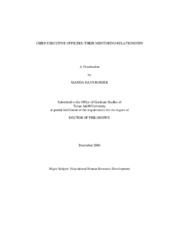| dc.description.abstract | The majority of mentoring research has explored mentoring from the vantage
point of protégé perceptions, reactions, experiences, and development (Wanberg et al.
2003; Kram, 1988). Participants in mentoring studies have commonly been employees,
college students, or mid-level managers. Little is known regarding the impact of
mentoring roles in relation to top executives who are, over the span of their careers,
likely to participate in developmental relationships as both mentor and protégé. In fact,
accessing people who are active CEOs has been extremely problematic for a majority of
interested researchers (Thomas, 1995). Limited research on mentoring and especially
that on CEOs is used to inform the current Human Resource Development (HRD)
scholarship and practice. The current study will inform HRD and provide insight into
how mentoring relationships can be used to develop individuals in organizations.
Key findings from this study were reported from a qualitative study (Moustakas,
1994) involving twelve CEOs of large for-profit US corporations who detailed their
experiences as both mentors and protégés. Emerging themes from the larger study
overlap, in part, with key mentoring functions as identified by Kram (1988). In addition
to reinforcing and informing the work of Kram (1988), key CEOs provided insight
regarding their experiences in long-term (several years or more) mentoring relationships.
The combined themes resulted in a framework demonstrating the development of
mentoring relationships.
In addition to a general discussion of a mentoring framework, I focused the study
primarily on CEO perceptions regarding the impact of their mentoring related
experiences on 1) how their mentors have impacted their development; 2) how they
mentor others; and 3) the relational elements in mentoring relationships. Because a
rarely assessed population was studied, scholars and practitioners in HRD will gain a
unique understanding and greater insight into how mentoring relationships develop
professionals, particularly CEOs. | en |


